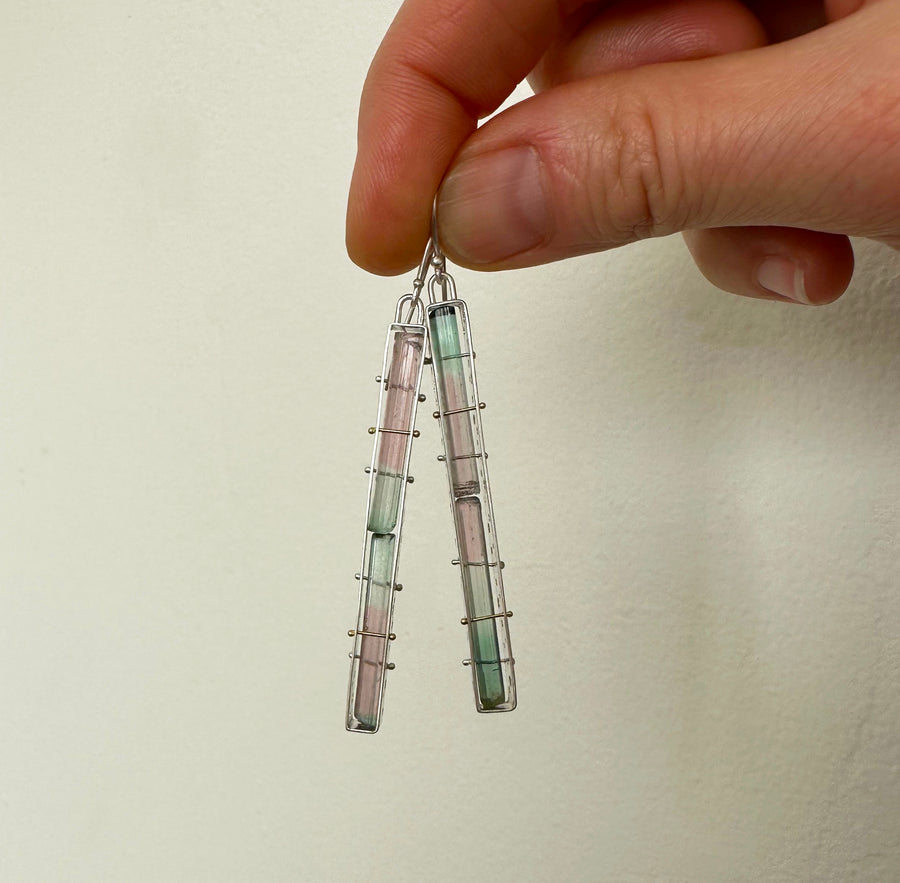It's no surprise that the Spanish conquistador who first discovered green tourmaline in Brazil in the 1500s mistook it for emerald. This versatile, semi-precious gem covers the entire color spectrum, ranging from vibrant reds, soft pinks, and peachy tones to deep emerald greens, bright yellows, and rich blues. Its wide range of colors sets it apart as a truly unique gem.
Tourmaline has various properties that make it ideal for jewelry and the perfect gift for October birthdays, since it joins opal as the month's birthstone. It also happens to be one of Hilary's favorite and most-requested gems! In this blog post, we’ll explore the different types of tourmaline, their meanings, and how to care for them.
What Is Tourmaline?
Tourmaline is a crystalline silicate mineral that belongs to the cyclosilicate group. It has a complex chemical formula that can vary depending on the type and color of the stone. Tourmaline crystals are usually elongated and have three-sided prisms. They can also form in clusters, needles, or thin slices. The long shape of many tourmaline crystals affects how the finished gem looks. This means there are often unusual, narrow sizes available. Gem cutters often make tourmalines into long rectangles to use the crystal efficiently.
Tourmaline is sourced from many places, but one of the earliest reports of tourmaline was actually first documented in California in 1892. George F. Kunz, a gemologist from Tiffany, played a key role in establishing tourmaline as an American gem. He wrote extensively about tourmaline deposits in Maine and California, where he spoke highly of the quality of the stones they yielded. Some other famous sources are Afghanistan, Brazil, Madagascar, Pakistan, and the United States. Brazil is known for high-quality, aqua-blue Paraiba tourmalines, which are some of the most coveted tourmalines in the world.
Since tourmaline comes in many colors, it's often confused with other minerals, especially quartz. But one quality that sets tourmaline apart is that it's strongly pleochroic, a quality to describe a gem that can show two or three colors when viewed from different angles. A tourmaline crystal that appears light green across its length can look dark green — or even almost black — when viewed down its length.
The color of tourmaline depends on the trace elements that are present in its structure, such as iron, manganese, chromium, vanadium, or copper.
Our Favorite Types of Tourmaline
Here are some of the most common and popular types of tourmaline:
Rubellite
Long ago mistaken for ruby, rubellite is available in bright pink and red colors. "Rubellite" is a trade term, so what distinguishes it from other pink tourmaline gems is its color, judged by a trained eye. It tends to be more saturated and vivid than standard pink tourmaline. Beloved by collectors, this gem is also sought after for its association with charming concepts like empathy and emotional healing.

Pink Tourmaline
This is one of the most sought-after and captivating colors of tourmaline. It ranges from pale pink to deep rose, and sometimes has a slight purple tint. This type of tourmaline is associated with love, compassion, and emotional healing.
Green Tourmaline
This is another popular and attractive color of tourmaline. It varies from light green to dark forest green, and sometimes has a yellowish or bluish tone. Green tourmaline is said to symbolize life, nature, and growth. It is also believed to bring luck, prosperity, and harmony.
Watermelon Tourmaline
This is a unique and fun type of tourmaline that has a green outer layer and a pink inner core, resembling a slice of watermelon. It is formed by a combination of pink and green tourmaline crystals that grow together. Watermelon tourmaline is considered to be a stone of balance, joy, and creativity.
Cat’s Eye Tourmaline
This is a rare and exotic type of tourmaline that exhibits a striking cat’s eye effect caused by the presence of fine, parallel inclusions of rutile, which create a narrow band of light that appears to move across the surface of the gemstone.
How to Care for Tourmaline Jewelry
Tourmaline is a durable and resilient gemstone that ranks 7 to 7.5 on the Mohs scale of hardness. However, it still requires some care and attention to keep it in its best condition. Here are some tips on how to care for your tourmaline jewelry:
- Clean your tourmaline jewelry with warm, soapy water and a soft toothbrush. Avoid using harsh chemicals, steam cleaners, or ultrasonic cleaners, as they can damage the color or clarity of the stone.
- Store your tourmaline jewelry separately from other pieces, especially those with harder stones that can scratch the surface of tourmaline. Wrap your tourmaline jewelry in a soft cloth or place it in a padded pouch to prevent any impacts or abrasions.
- Avoid exposing your tourmaline jewelry to extreme heat or sudden temperature changes, as they can cause cracks or color changes in the stone. Some tourmaline stones may have been treated with heat or irradiation to enhance their color, and these treatments can fade or reverse with exposure to heat or light.
- Handle your tourmaline jewelry with care and avoid wearing it when doing activities that can cause damage, such as sports, gardening, or cleaning. Remove your tourmaline jewelry before applying any cosmetics, perfumes, or hairsprays, as they can leave residues or stains on the stone.
Unique Tourmaline Jewelry
Each tourmaline gem has a distinctive charm, meaning, and energy, making it a perfect choice for any occasion. Whether you want to express your love, celebrate your birthday, or simply treat yourself, you can find a tourmaline that suits you. At Hilary Finck, we offer a wide range of unique tourmaline jewelry, handcrafted with passion and creativity. Check it out!






